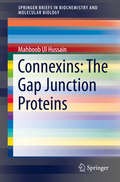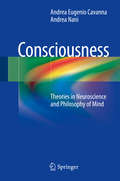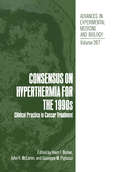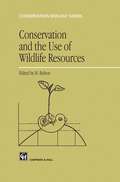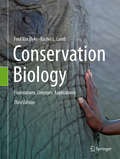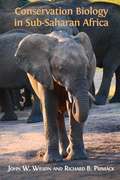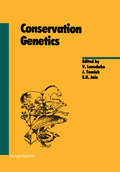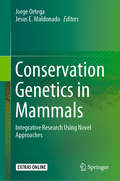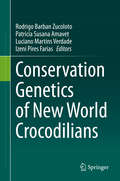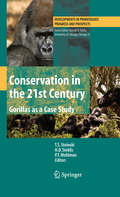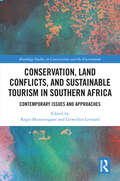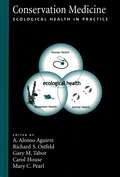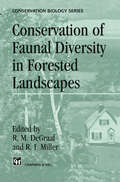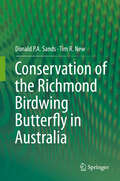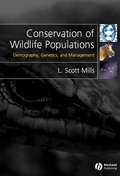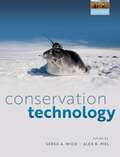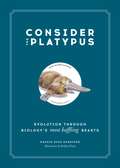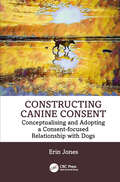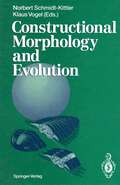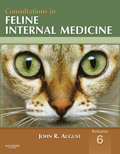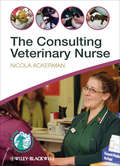- Table View
- List View
Connexins: The Gap Junction Proteins (SpringerBriefs in Biochemistry and Molecular Biology)
by Dr. Mahboob HussainGap-junction proteins, connexins are important cellular entities that regulate various facets of cellular physiology. The connexins constitute large family of proteins. The present book provides basic overview about various aspects of connexin proteins. The book has tried to touch the fundamental aspects of connexin family. This book will be useful to broad audience that includes under-and post-graduate students, research scholars, clinicians, etc. The reference section at the end of the book will be helpful for those who seek to know deeper details about this family of proteins.
Consciousness: Theories in Neuroscience and Philosophy of Mind
by Andrea Eugenio Cavanna Andrea NaniThis book reviews some of the most important scientific and philosophical theories concerning the nature of mind and consciousness. Current theories on the mind-body problem and the neural correlates of consciousness are presented through a series of biographical sketches of the most influential thinkers across the fields of philosophy of mind, psychology and neuroscience. The book is divided into two parts: the first is dedicated to philosophers of mind and the second, to neuroscientists/experimental psychologists. Each part comprises twenty short chapters, with each chapter being dedicated to one author. A brief introduction is given on his or her life and most important works and influences. The most influential theory/ies developed by each author are then carefully explained and examined with the aim of scrutinizing the strengths and weaknesses of the different approaches to the nature of consciousness.
Consensus on Hyperthermia for the 1990s: Clinical Practice in Cancer Treatment (Advances in Experimental Medicine and Biology #267)
by Haim I. Bicher John R. McLaren Giuseppe M. PigliucciHyperthermia as a safe and effective cancer treatment modality is rapidly evolving propelled by widespread research and clinical efforts worldwide. Presentations on Hyperthermia experience are now commonplace at Oncology meetings, as are congresses dedicated entirely to the intertwined interactions between basic sciences and patient treatment that together are forming the structure of a new medical specialty. Such was the XII International Symposium on Clinical Hyperthermia held in Rome, Italy, April 27 - 29, 1989. Papers presented therein constitute the backbone of this book. Biology research has provided data describing mechanisms of action for the cancer cell killing and physiological effects of Hyperthermia. Physics research has led to the development of equipment enabling treatment of many areas of the human body, as well as explained the limitations that still constrain our ability to treat, especially in the areas of deep seated tumor heating and non-invasive thermometry. The main question that will decide the future of this modality is that of its clinical use. To put it succinctly, what do we do with this potentially useful tool in an everyday clinical oncological practice . •• ? This is the main question addressed in this book as "Consensus on Hyperthermia for the 1990s. " The book in cludes 28 presented papers and 25 invited chapters from some of the leading experts in the field. Their basic mechanisms of action were physics principles, treatment quality assurance and especially, clinical indications.
Conservation and the Use of Wildlife Resources (Conservation Biology #8)
by M. Bolton Jeannette L. JohnsonNot everybody cares about the fate of wild animals or the state of the natural environment. I met a lady who said it wouldn't worry her if all the wild animals in the world disappeared overnight. She was a city person~ she said. There are also people who would prefer to let animals become extinct than to have them kept in captivity - no matter how progressive the zoo. There are those who, on principle, will not eat meat, let alone do the killing, and there are those who enjoy nothing so much as shooting birds. People in the last two camps may oppose each other in claiming to be con servationists. Extremists are unlikely to find their opinions being reversed by this book but, because of the scope of the subject, I believe there is a good chance that anybody with an interest in wildlife will find in it something new to think about. It may not be too much to hope that a few disagreements might also be settled because I suspect there is more common ground than is generally realized among those with opposing views.
Conservation Behavior: Applying Behavioral Ecology To Wildlife Conservation And Management (PDF) (Conservation Biology Ser. #21)
by Oded Berger-Tal David SaltzConservation behavior assists the investigation of species endangerment associated with managing animals impacted by anthropogenic activities. It employs a theoretical framework that examines the mechanisms, development, function, and phylogeny of behavior variation in order to develop practical tools for preventing biodiversity loss and extinction. Developed from a symposium held at the International Congress on Conservation Biology in 2011, this is the first book to offer an in-depth, logical framework that identifies three vital areas for understanding conservation behavior: anthropogenic threats to wildlife, conservation and management protocols, and indicators of anthropogenic threats. Bridging the gap between behavioral ecology and conservation biology, this volume ascertains key links between the fields, explores the theoretical foundations of these linkages, and connects them to practical wildlife management tools and concise applicable advice. Adopting a clear and structured approach throughout, this book is a vital resource for graduate students, academic researchers, and wildlife managers.
Conservation Biology: Foundations, Concepts, Applications
by Rachel L. Lamb Fred Van DykeThis book provides a thorough, up-to-date examination of conservation biology and the many supporting disciplines that comprise conservation science. In this, the Third Edition of the highly successful Conservation Biology: Foundations, Concepts, Applications, the authors address their interdisciplinary topic as it must now be practiced and perceived in the modern world. Beginning with a concise review of the history of conservation, the authors go on to explore the interplay of conservation with genetics, demography, habitat and landscape, aquatic environments, and ecosystem management, and the relationship of all these disciplines to ethics, economics, law, and policy. An entirely new chapter, The Anthropocene: Conservation in a Human-Dominated Nature, breaks new ground in its exploration of how conservation can be practiced in anthropogenic biomes, novel ecosystems, and urban habitats. The Third Edition includes the popular Points of Engagement discussion questions used in earlier editions, and adds a new feature: Information Boxes, which briefly recap specific case histories described in the text. A concluding chapter offers insight into how to become a conservation professional, in both traditional and non-traditional roles.The authors, Fred Van Dyke and Rachel Lamb, draw on their expertise as field biologists, wildlife managers, consultants to government and industry, and scholars of environmental law, policy, and advocacy, as well as their many years of effective teaching experience. Informed by practical knowledge and acquired skills, the authors have created a work of exceptional clarity and readability which encompasses both systemic foundations as well as contemporary developments in the field. Conservation Biology: Foundations, Concepts, Applications will be of invaluable benefit to undergraduate and graduate students, as well as to working conservation scientists and managers.This is an amazing resource for students, faculty, and practitioners both new and experienced to the field. Diane Debinski, PhD Unexcelled wisdom for living at home on Wonderland Earth, the planet with promise, destined for abundant life. Holmes Rolston, PhDVan Dyke and Lamb have maintained the original text’s emphasis on connecting classical ecological and environmental work with updated modern applications and lucid examples. But more importantly, the third edition contains much new material on the human side of conservation, including expanded treatments of policy, economics, and climate change. Tim Van Deelen, PhD Fred Van Dyke and Rachel Lamb break new ground in both the breadth and depth of their review and analysis of this crucially important and rapidly changing field. Any student or other reader wishing to have a comprehensive overview and understanding of the complexities of conservation biology need look no further – this book is your starting point! Simon N. Stuart, PhD
Conservation Biology in Sub-Saharan Africa
by John W. Wilson Richard B. PrimackConservation Biology in Sub-Saharan Africa comprehensively explores the challenges and potential solutions to key conservation issues in Sub-Saharan Africa. Easy to read, this lucid and accessible textbook includes fifteen chapters that cover a full range of conservation topics, including threats to biodiversity, environmental laws, and protected areas management, as well as related topics such as sustainability, poverty, and human-wildlife conflict. This rich resource also includes a background discussion of what conservation biology is, a wide range of theoretical approaches to the subject, and concrete examples of conservation practice in specific African contexts. Strategies are outlined to protect biodiversity whilst promoting economic development in the region. Boxes covering specific themes written by scientists who live and work throughout the region are included in each chapter, together with recommended readings and suggested discussion topics. Each chapter also includes an extensive bibliography. Conservation Biology in Sub-Saharan Africa provides the most up-to-date study in the field. It is an essential resource, available on-line without charge, for undergraduate and graduate students, as well as a handy guide for professionals working to stop the rapid loss of biodiversity in Sub-Saharan Africa and elsewhere.
Conservation Genetics (Experientia Supplementum #68)
by V. Loeschcke J. Tomiuk S. K. JainIt follows naturally from the widely accepted Darwinian dictum that failures of populations or of species to adapt and to evolve under changing environments will result in their extinction. Population geneti cists have proclaimed a centerstage role in developing conservation biology theory and applications. However, we must critically reexamine what we know and how we can make rational contributions. We ask: Is genetic variation really important for the persistence of species? Has any species become extinct because it ran out of genetic variation or because of inbreeding depression? Are demographic and environmental stochas ticity by far more important for the fate of a population or species than genetic stochasticity (genetic drift and inbreeding)? Is there more to genetics than being a tool for assessing reproductive units and migration rates? Does conventional wisdom on inbreeding and "magic numbers" or rules of thumb on critical effective population sizes (MVP estimators) reflect any useful guidelines in conservation biology? What messages or guidelines from genetics can we reliably provide to those that work with conservation in practice? Is empirical work on numerous threatened habitats and taxa gathering population genetic information that we can use to test these guidelines? These and other questions were raised in the invitation to a symposium on conservation genetics held in May 1993 in pleasant surroundings at an old manor house in southern Jutland, Denmark.
Conservation Genetics in Mammals: Integrative Research Using Novel Approaches
by Jorge Ortega Jesus E. MaldonadoThis book focuses on the use of molecular tools to study small populations of rare and endangered mammals, and presents case studies that apply an evolutionary framework to address innovative questions in the emerging field of mammalian conservation genomics using a highly diverse set of novel molecular tools. Novel and more precise molecular technologies now allow experts in the field of mammology to interpret data in a more contextual and empirical fashion and to better describe the evolutionary and ecological processes that are responsible for the patterns they observe. The book also demonstrates how recent advances in genetic/genomic technologies have been applied to assess the impact of environmental/anthropogenic changes on the health of small populations of mammals. It examines a range of issues in the field of mammalian conservation genomics, such as the role that the genetic diversity of the immune system plays in disease protection and local adaptation; the use of noninvasive techniques and genomic banks as a resource for monitoring and restoring populations; the structuring of population by physical barriers; and genetic diversity. Further, by integrating research from a variety of areas – including population genetics, molecular ecology, systematics, and evolutionary and conservation biology – it enables readers to gain a deeper understanding of the conservation biology of mammals that are at increasing risk of extinction at local, regional and global scales. As such, it offers a unique resource for a broad readership interested in the conservation biology of mammals and conservation management strategies to better preserve biodiversity.
Conservation Genetics of New World Crocodilians
by Rodrigo Barban Zucoloto Patricia Susana Amavet Luciano Martins Verdade Izeni Pires FariasThis book aims to be a comprehensive review of the literature on the conservation genetics of the New World crocodilians, from the biological and demographical aspects of the living species to the application of molecular techniques for conservation purposes. It covers the current status of the molecular genetics applied to phylogenetics, phylogeography, diversity, kinship and mating system, and hybridization, as well its implications for decision making with regards to the conservation of these species at academic and governmental levels. This book can be used as a guide for graduate and undergraduate students to understand how conservation genetics techniques are carried out and how they can help preserve not only crocodilians but also other living species.
Conservation in the 21st Century: Gorillas As A Case Study (Developments in Primatology: Progress and Prospects)
by T. S. Stoinski P. T. Mehlman H. D. SteklisThis volume identifies the primary problems faced in conserving wild populations of gorillas throughout Africa, pinpointing new approaches to solving these problems and outlining the increased role that zoos can play in gorilla conservation. It includes the in-depth expertise of field scientists in a variety of disciplines to discuss current conservation threats, novel approaches to conservation, and potential solutions.
Conservation, Land Conflicts and Sustainable Tourism in Southern Africa: Contemporary Issues and Approaches (Routledge Studies in Conservation and the Environment)
by Regis Musavengane Llewellyn LeonardThis book examines the nexus between conservation, land conflicts and sustainable tourism approaches in Southern Africa, with a focus on equity, access, restitution and redistribution. While Southern Africa is home to important biodiversity, pristine woodlands and grasslands, and is a habitat for important wildlife species, it is also a land of contestations over its natural resources with a complex historical legacy and a wide variety of competing and conflicting issues surrounding race, cultural and traditional practices and neoliberalism. Drawing on insights from conservation, environmental and tourism experts, this volume presents the nexus between land conflicts and conservation in the region. The chapters reveal the hegemony of humans on land and associated resources including wildlife and minerals. By using social science approaches, the book unites environmental, scientific, social and political issues as it is imperative we understand the holistic nature of land conflicts in nature-based tourism. Discussing the management theories and approaches to community-based tourism in communities where there is or were land conflicts is critical to understanding the current state and future of tourism in African rural spaces. This volume determines the extent to which land reform impacts community-based tourism in Africa to develop resilient destination strategies and shares solutions to existing land conflicts to promote conservation and nature-based tourism. The book will be of great interest to students, academics, development experts, and policymakers in the field of conservation, tourism geography, sociology, development studies, land use and environmental management and African studies.
Conservation, Land Conflicts and Sustainable Tourism in Southern Africa: Contemporary Issues and Approaches (Routledge Studies in Conservation and the Environment)
by Regis Musavengane and Llewellyn LeonardThis book examines the nexus between conservation, land conflicts and sustainable tourism approaches in Southern Africa, with a focus on equity, access, restitution and redistribution. While Southern Africa is home to important biodiversity, pristine woodlands and grasslands, and is a habitat for important wildlife species, it is also a land of contestations over its natural resources with a complex historical legacy and a wide variety of competing and conflicting issues surrounding race, cultural and traditional practices and neoliberalism. Drawing on insights from conservation, environmental and tourism experts, this volume presents the nexus between land conflicts and conservation in the region. The chapters reveal the hegemony of humans on land and associated resources including wildlife and minerals. By using social science approaches, the book unites environmental, scientific, social and political issues as it is imperative we understand the holistic nature of land conflicts in nature-based tourism. Discussing the management theories and approaches to community-based tourism in communities where there is or were land conflicts is critical to understanding the current state and future of tourism in African rural spaces. This volume determines the extent to which land reform impacts community-based tourism in Africa to develop resilient destination strategies and shares solutions to existing land conflicts to promote conservation and nature-based tourism. The book will be of great interest to students, academics, development experts, and policymakers in the field of conservation, tourism geography, sociology, development studies, land use and environmental management and African studies.
Conservation Medicine: Ecological Health in Practice
by A. Alonso Aguirre, Richard S. Ostfeld, Gary M. Tabor, Carol House and Mary C. PearlConservation medicine is an emerging discipline, focussing on the intersection of ecosystem health, animal health, and human health. Work in the biomedical and veterinary sciences is now being folded into conservation biology; to explore the connections between animal and human health; trace the environmental sources of pathogens and pollutants; develop an understanding of the ecological causes of changes in human and animal health; and understand the consequences of diseases to populations and ecological communities. Conservation Medicine defines this new discipline. It examines ecological health issues from various standpoints, including the emergence and resurgence of infectious disease agents; the increasing impacts of toxic chemicals and hazardous substances; and the health implications of habitat fragmentation and degradation and loss of biodiversity. It will provide a framework to examine the connections between the health of the planet and the health of all species and challenge practitioners and students in the health sciences and natural sciences to think about new, collaborative ways to address ecological health concerns.
Conservation Medicine: Ecological Health in Practice
by Mary C. Pearl A. Alonso Aguirre Richard S. Ostfeld Gary M. Tabor Carol HouseConservation medicine is an emerging discipline, focussing on the intersection of ecosystem health, animal health, and human health. Work in the biomedical and veterinary sciences is now being folded into conservation biology; to explore the connections between animal and human health; trace the environmental sources of pathogens and pollutants; develop an understanding of the ecological causes of changes in human and animal health; and understand the consequences of diseases to populations and ecological communities. Conservation Medicine defines this new discipline. It examines ecological health issues from various standpoints, including the emergence and resurgence of infectious disease agents; the increasing impacts of toxic chemicals and hazardous substances; and the health implications of habitat fragmentation and degradation and loss of biodiversity. It will provide a framework to examine the connections between the health of the planet and the health of all species and challenge practitioners and students in the health sciences and natural sciences to think about new, collaborative ways to address ecological health concerns.
Conservation of Faunal Diversity in Forested Landscapes (Conservation Biology #6)
by Richard M. DeGraaf Ronald I. MillerForest wildlife conservation is critically required in many parts of the world today. This book presents a merger between the elements of wildlife conservation and habitat conservation, and explains how these disciplines can be used to promote the conservation of vertebrates in forests around the world.
Conservation of the Richmond Birdwing Butterfly in Australia
by Donald P.A. Sands Tim R. NewThis survey of one the longest insect conservation campaigns in Australia deals with recovery of one of the most iconic endemic butterflies, the Richmond birdwing, threatened by clearance and fragmentation of subtropical rainforest in eastern Australia and the spread of an alien larval food-plant. Its conservation has involved many aspects of community involvement, developed over more than 20 years, and focused on habitat restoration and weed eradication, in conjunction with conservation of remaining forest fragments. The work has involved the entire historical range of the butterfly, addressed threats and emphasised landscape connectivity, and has enhanced recovery through extensive plantings of native food plants. Interest has been maintained through extensive publicity, community education and media activity, and the programme has provided many lessons for advancing insect conservation practice in the region.
Conservation of Wildlife Populations: Demography, Genetics and Management
by L. Scott MillsProfessor L. Scott Mills has been named a 2009 Guggenheim Fellow by the board of trustees of the John Simon Guggenheim Memorial Foundation. Conservation of Wildlife Populations provides an accessible introduction to the most relevant concepts and principles for solving real-world management problems in wildlife and conservation biology. Bringing together insights from traditionally disparate disciplines, the book shows how population biology addresses important questions involving the harvest, monitoring, and conservation of wildlife populations. Covers the most up-to-date approaches for assessing factors that affect both population growth and interactions with other species, including predation, genetic changes, harvest, introduced species, viability analysis and habitat loss and fragmentation. Is an essential guide for undergraduates and postgraduate students of wildlife biology, conservation biology, ecology, and environmental studies and an invaluable resource for practising managers on how population biology can be applied to wildlife conservation and management. Artwork from the book is available to instructors online at www.blackwellpublishing.com/mills. An Instructor manual CD-ROM for this title is available. Please contact our Higher Education team at HigherEducation@wiley.com for more information.
Conservation Technology
The global loss of biodiversity is occurring at an unprecedented pace. Despite the considerable effort devoted to conservation science and management, we still lack even the most basic data on the distribution and density of the majority of plant and animal species, which in turn hampers our efforts to study changes over time. In addition, we often lack behavioural data from the very animals most influenced by environmental changes; this is largely due to the financial and logistical limitations associated with gathering scientific data on species that are cryptic, widely distributed, range over large areas, or negatively influenced by human presence. To overcome these limitations, conservationists are increasingly employing technology to facilitate such data collection. Innovative solutions have been driven by dramatic advances in the conservation-technology interface. The use of camera traps, acoustic sensors, satellite data, drones, and computer algorithms to analyse the large datasets collected are all becoming increasingly widespread. Although specialist books are available on some of these individual technologies, this is the first comprehensive text to describe the breadth of available technology for conservation and to evaluate its varied applications, bringing together a team of international experts using a diverse range of approaches. Conservation Technology is suitable for graduate level students, professional researchers, practitioners and field managers in the fields of ecology and conservation biology.
Consider the Platypus: Evolution through Biology's Most Baffling Beasts
by Maggie Ryan Sandford*FINALIST FOR THE 2020 GENERAL NONFICTION MINNESOTA BOOK AWARDS*Interested in the origins of the species? Consider the Platypus uses pets such as dogs and cats as well as animal outliers like the axolotl and naked mole rat to wittily tackle mind-bending concepts about how evolution, biology, and genetics work.Consider the Platypus explores the history and features of more than 50 animals to provide insight into our current understanding of evolution. Using Darwin's theory as a springboard, Maggie Ryan Sandford details scientists' initial understanding of the development of creatures and how that has expanded in the wake of genetic sequencing, including the:Peppered Moth, which changed color based on the amount of soot in the London air;California Two-Spotted Octopus, which has the amazing ability to alter its DNA/RNA not over generations but during its lifetime;miniscule tardigrade, which is so hearty it can withstand radiation, lack of water and oxygen, and temperatures as low as -328°F and as high 304 °F;and, of course, the platypus, which has so many disparate features, from a duck's bill to venomous spur to mammary patches, that scientists originally thought it was a hoax. Surprising, witty, and impeccably researched, Sandford describes each animal's significant features and how these have adapted to its environment, such as the zebra finch's beak shape, which was observed by Charles Darwin and is a cornerstone of his Theory of Evolution. With scientifically accurate but charming art by Rodica Prato, Consider the Platypus showcases species as diverse as the sloth, honey bee, cow, brown kiwi, and lungfish, to name a few, to tackle intimidating concepts is a accessible way.
Constructing Canine Consent: Conceptualising and adopting a consent-focused relationship with dogs
by Erin JonesThe concept of canine consent is far more than simply a buzzword in modern dog training practices. In its current form, consent is a distinctly human concept, designed by humans and for humans. Looking beyond species boundaries can help us not only consider concepts of canine consent and autonomy, but it can also help us to apply these concepts in our everyday interactions with dogs, which is fundamental for any professional working with dogs as well as for everyday dog caregivers. This canine-indexed definition of consent includes a model of five major categories: Touch/interaction-based consent, cooperative care using learned consent behaviours, activity consent, consent-based learning, and substitutive consent. These categories involve a two-way communication system, integration of salient choices, teaching consent behaviours and incorporating existing training protocols that adhere to the Humane Hierarchy of best practices, and an evaluation of dependent decision-making in extenuating circumstances. This book aims to merge the existing literature and new understandings about canine consent to paint a complete picture. It will challenge the current expectations of dogs and dog behaviour in our society with an intention of considering their perspectives, experiences, and emotional needs. It will be important reading for veterinary professionals, dog trainers and behaviourists, those involved in work with therapy dogs, and anybody working with or caring for dogs.
Constructing Canine Consent: Conceptualising and adopting a consent-focused relationship with dogs
by Erin JonesThe concept of canine consent is far more than simply a buzzword in modern dog training practices. In its current form, consent is a distinctly human concept, designed by humans and for humans. Looking beyond species boundaries can help us not only consider concepts of canine consent and autonomy, but it can also help us to apply these concepts in our everyday interactions with dogs, which is fundamental for any professional working with dogs as well as for everyday dog caregivers. This canine-indexed definition of consent includes a model of five major categories: Touch/interaction-based consent, cooperative care using learned consent behaviours, activity consent, consent-based learning, and substitutive consent. These categories involve a two-way communication system, integration of salient choices, teaching consent behaviours and incorporating existing training protocols that adhere to the Humane Hierarchy of best practices, and an evaluation of dependent decision-making in extenuating circumstances. This book aims to merge the existing literature and new understandings about canine consent to paint a complete picture. It will challenge the current expectations of dogs and dog behaviour in our society with an intention of considering their perspectives, experiences, and emotional needs. It will be important reading for veterinary professionals, dog trainers and behaviourists, those involved in work with therapy dogs, and anybody working with or caring for dogs.
Constructional Morphology and Evolution
by H. SchäferConstructional morphology explains features of organisms from a constructional and functional point of view. By means of physical analysis it explains the operational aspects of organic structures - how they can perform the activities organisms are expected to fulfil in order to survive in their environment. Constructional morphology also explains options and constraints during the evolution determined by internal constructional needs, ontogenetic demands, inherited organizational preconditions and environmental clues.
Consultations in Feline Internal Medicine, Volume 6 - E-Book
by John R. AugustCompletely revised and updated with 80 all-new chapters covering the most important information on current diagnostic, treatment, and preventive challenges facing feline practitioners today, Consultations in Feline Internal Medicine is an invaluable addition to every small animal clinician’s library. Full-color illustrations and expert contributions help you master and apply the latest advances in feline nutrition, emerging diseases, pet overpopulation, advanced imaging, and more with a comprehensive, clinically relevant approach. More than 100 worldwide leaders in small animal practice provide expert insight across the full spectrum of feline internal medicine. Extensive references make it easy to find additional information about specific topics most important to your practice. Current, evidence-based coverage reflects the latest findings and reports on pressing topics such as: Upper Respiratory Tract Aspergillosis Exocrine Pancreatic Insufficiency Diagnostic Imaging of the Ear Cardiac Blood Tests Urological Interventional Techniques A new section on feline nutrition highlights the impact of nutritional considerations on feline health. A dynamic full-color design, incorporating hundreds of NEW illustrations and tables, clarifies concepts and helps you interpret clinical data.
The Consulting Veterinary Nurse
by Nicola AckermanThe Consulting Veterinary Nurse is an invaluable source of information for all veterinary nurses setting up and conducting their own nursing clinics in small animal practice. From the basics of setting up the consulting room to running and marketing individual clinics, this book provides a comprehensive coverage of the role of the consulting veterinary nurse. A large section of the book details specific clinics run by nurses, including nutritional assessments, behavioural clinics, puppy parties, seasonal information campaigns, senior pet clinics and medical clinics for a full range of conditions from arthritis and dental problems to epilepsy and cancer. A chapter specifically on rabbit clinics is also included. Written by an experienced senior veterinary nurse, this is a vital guide for all veterinary nurses seeking to develop their consulting role and contribute effectively to the long-term success of their practice. KEY FEATURES Provides a comprehensive guide to the role of the consulting veterinary nurse Details specific nutritional, medical and behavioural clinics run by nurses Includes advice on presentation, marketing and communicating with clients Discusses client compliance and internal procedure and protocol Contains sample diet history sheets and unit conversion charts for use in practice Endorsed by the British Veterinary Nursing Association
